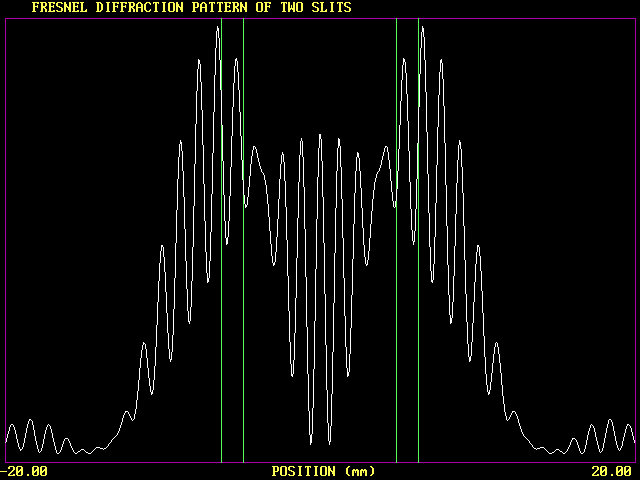Diffraction Pattern Samples
The following thumbnails are sample diffraction pattern outputs
of the BASIC program
DIFFRACT.BAS
using various obstacles and laser types.
All examples use a source to obtacle distance
of 88 millimeters and an obstacle to screen
distance of 1.469 meters. These parameters
were chosen to produce a screen sampling resolution of
approximately 0.125 millimeters using a 320X200 simulation,
this reduces the proplem of undersampling and aliasing,
which should be addressed in a future version of the program.

- Wire obstacle with gaussian beam illumination
- Red Helium-Neon laser (632.82 nm)
- Wire width is 0.2 mm
- Scanned from -25 to +25 mm

- Rectangular aperture with uniform illumination
- Yellow Dye laser (580 nm)
- Aperture width and height : 1.0 by 1.8 mm
- Scanned from -20 to +20 mm

- Straight edge obstacle with uniform illumination
- Blue Helium-Cadmium laser (441 nm)
- Obstacle edge center at 0.2 mm
- Scanned from -20 to +20 mm

- Two slits with uniform illumination
- Yellow-Green Copper vapour laser (510.5 nm)
- First slit is 0.08mm; second slit is 0.08 mm, separated by 0.55 mm
- Scanned from -20 to +20 mm
The program is capable of producing laser printer
output with an extremely high resolution of 3300 by 2400 pixels
or higher (8.5 by 11 inch at 300 DPI. Landscape).
- Download
PLOT.PLT,
sample HPGL plotter/laser printer output (27 kBytes)
- View lower resolution
1024 by 768 GIF
rendering of above file (16 kBytes).
The parameters for this wire diffraction pattern are tabulated in
the paper on
'Laser Diffraction'
(see data on
Figure number 2).
To print the HPGL file to a LaserJet compatible laser printer
use the following commands at the DOS prompt:
copy /b PLOT.PLT LPT1 /v
You can also view HPGL files with programs
such as CorelDRAW 7.
Return to Laser Diffraction Simulation page.



